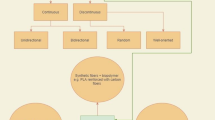Abstract
An approach to developing a damage prognosis solution that integrates advanced sensing technology, data interrogation procedures for damage detection, novel model validation and uncertainty quantification techniques, and reliability-based decision-making algorithms is summarized in this article. In parallel, experimental efforts are underway to deliver a proof-of-principle technology demonstration by assessing impact damage and predicting the subsequent fatigue damage accumulation in a composite plate. This article provides an overview of the various technologies that are being integrated to address this damage prognosis problem.
Similar content being viewed by others
References
C.R. Farrar et al., Damage Prognosis: Current Status and Future Needs (Los Alamos National Laboratory report LA-14051-MS, 2003).
S.W. Doebling et al., Damage Identification and Health Monitoring of Structural and Mechanical Systems from Changes in their Vibration Characteristics: A Literature Review (Los Alamos National Laboratory report LA-13070-MS, 1996).
H. Sohn et al., A Review of Structural Health Monitoring Literature from 1996–2001 (Los Alamos National Laboratory report LA-13976-MS, 2003).
A.G. Star and B.K.N. Rap, eds., Condition Monitoring and Diagnostic Eng. Management (Amsterdam, Netherlands: Elsevier Science BV, 2001).
T. Tippetts, I. Beyerlein, and T. Williams, “A Multiscale/Cohesive Zone Model for Composite Laminate Impact Damage” (Paper presented at the Am. Soc. of Comp. 17th Tech. Conf., Lafayette, IN, 2002).
G. Park et al., “Overview of Piezoelectric Impedance-based Health Monitoring and Path Forward,” accepted for publication in The Shock and Vibration Digest.
Proceedings of the International Workshop on Smart Materials and Smart Structures Technology-2004, (Lancaster, PA: DEStech Publications) in press.
Author information
Authors and Affiliations
Additional information
Editor’s Note: Presentation of this paper is supported by the Air Force Research Laboratory, under agreement number F33615-01-D-5801. The U.S. Government is authorized to reproduce and distribute reprints for governmental purposes notwithstanding any copyright notation thereon. The views and conclusions contained herein are those of the authors and should not be interpreted as necessarily representing the official policies or endorsements, either expressed or implied, of the Air Force Research Laboratory or the U.S. Government.
For more information, contact Charles Farrar, Los Alamos National Laboratory, MST-006, Los Alamos, NM 87545; e-mail farrar@lanl.gov.
Rights and permissions
About this article
Cite this article
Farrar, C., Hemez, F., Park, G. et al. Developing impact and fatigue damage prognosis solutions for composites. JOM 56, 40–42 (2004). https://doi.org/10.1007/s11837-004-0031-8
Issue Date:
DOI: https://doi.org/10.1007/s11837-004-0031-8




